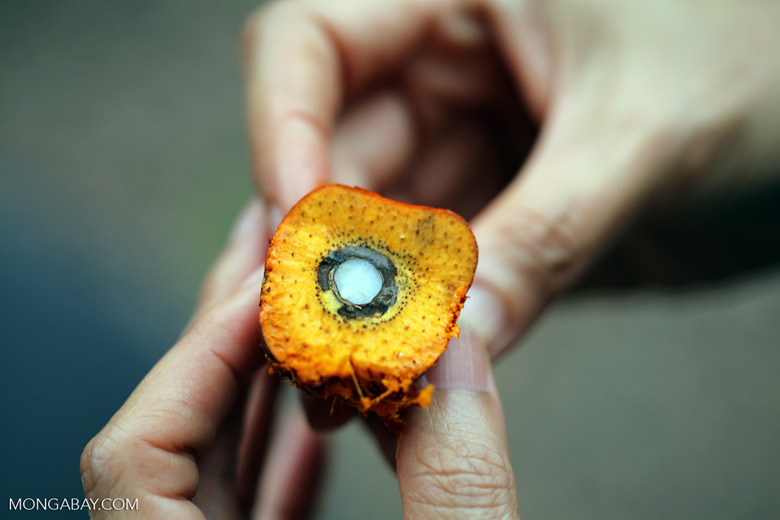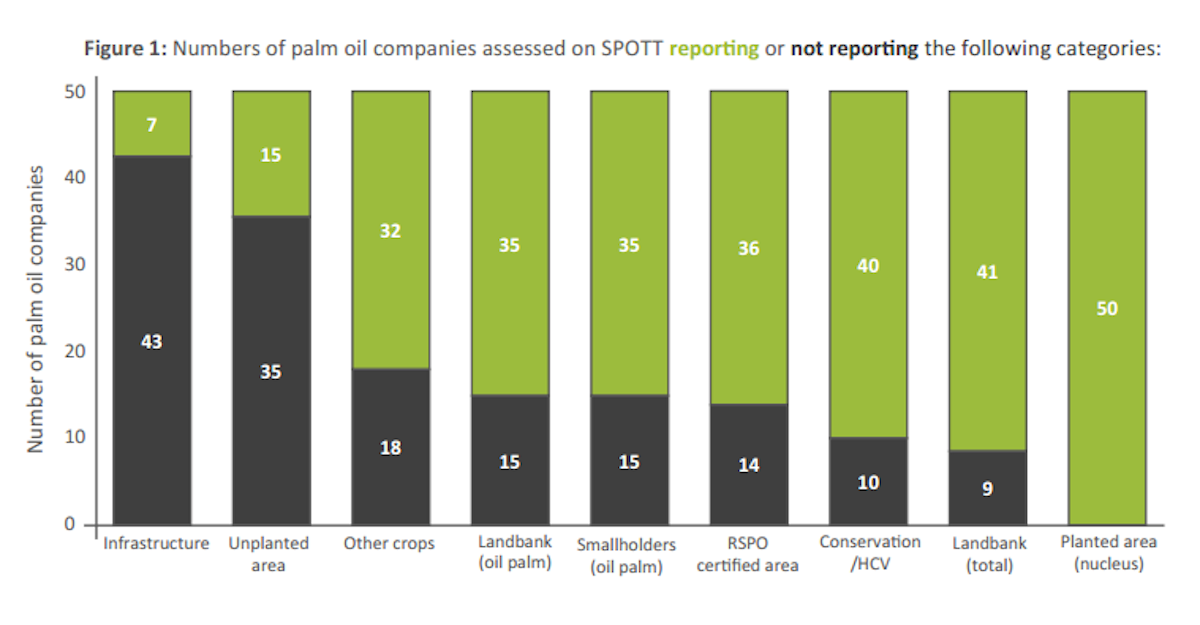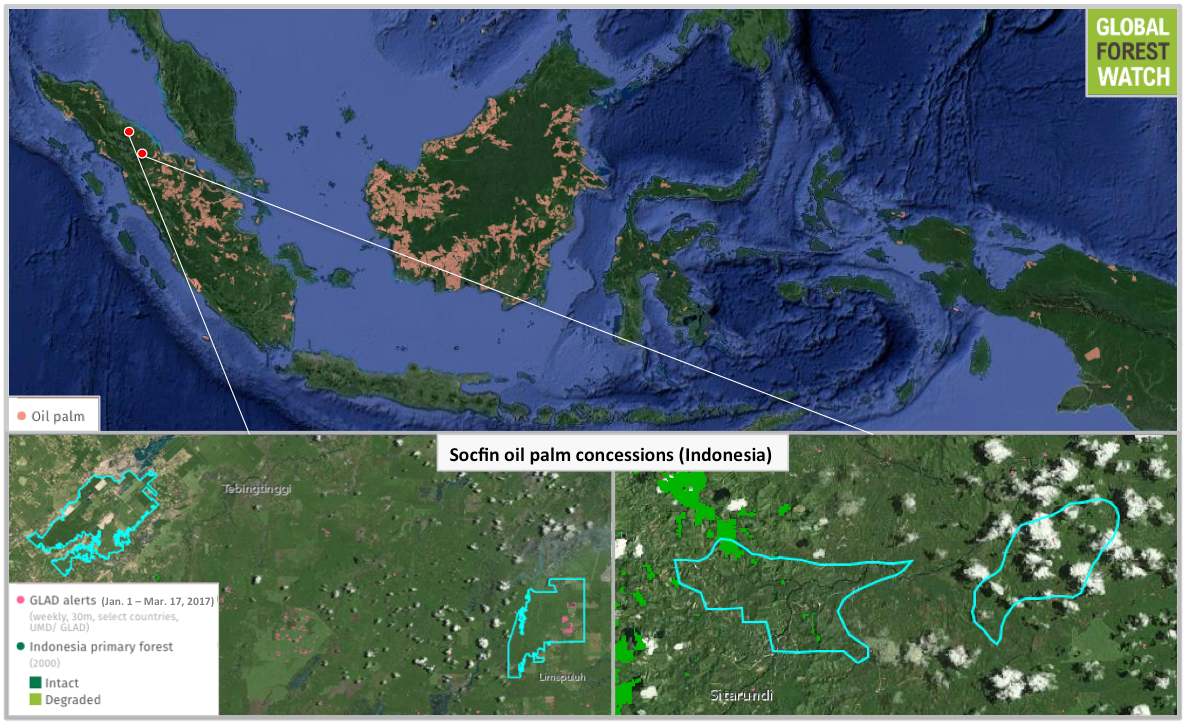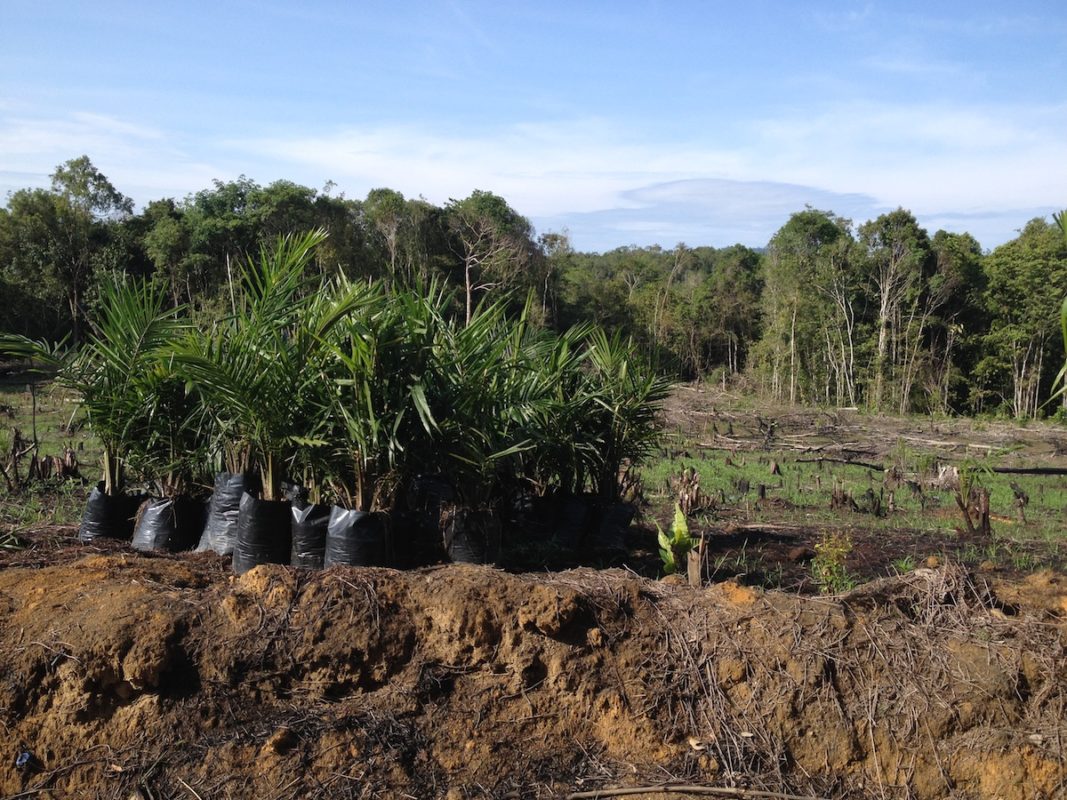- Palm oil is a major driver of tropical deforestation. The report was produced by the Zoological Society of London (ZSL), which looked at information publicly disclosed by 50 of the most major palm oil production companies.
- Its findings indicate that while most companies disclose the area of planted land they manage, many fail to reveal the size, location, and use of many other areas in their portfolio, defying corporate accountability and concealing potential social and environmental risks.
- A supply chain expert says failures to disclose information don’t necessarily signal ill will on the part of the companies. Instead, it may be the result of unclear expectations, definitions, and protocols for reporting.
- The Round Table for Sustainable Palm Oil (RSPO), the world’s leading palm oil certification body, is reportedly working to improve the reporting process of its member companies.
Nearly a million hectares are “missing” from landbanks of the world’s top palm oil producers, a new report shows. While most companies disclose the area of planted land they manage, many fail to reveal the size, location, and use of many other areas in their portfolio, defying corporate accountability and concealing potential social and environmental risks.
“This misreporting potentially excludes vast areas of land at environmental and social risk – such as undeveloped land that, if converted into plantations in the future, could be at risk of environmental damage, including deforestation,” Zoological Society of London (ZSL), the non-profit that produced the report, wrote in a press release.
Where information is disclosed by palm oil companies, ZSL found it’s often inconsistently reported, making it difficult for investors and certification bodies to hold them accountable.
“It’s a murky world that we’re finding,” Izabela Delabre of ZSL’s Sustainable Palm Oil Transparency Toolkit (SPOTT), told Mongabay. “In one place the companies are saying one thing and in another place they’re saying something else.”
The footprint of the palm oil industry is large in many dimensions, research has shown. Plantations of palm oil trees, the fruit of which is processed to make products ranging from peanut butter to shampoo, are not only expansive – covering up to 27 million hectares globally, according to ZSL – but are also known to supplant rainforests. Indeed, palm oil is one of the leading drivers of tropical deforestation.

The demand for palm oil remains on trend to double by mid-century, the researchers write, making the “continued impacts of land use…urgent priorities that need to be addressed.” Doing so, they add, hinges on corporate transparency – accurate reporting on land that a company manages.
“It is essential to understanding the current and future impacts of the industry, and an important first step in identifying and prioritising the mitigation of risks associated with specific companies,” they write.
Sarah Lake, head of The Drivers of Deforestation Program at Global Canopy Program, agrees.
“Without understanding what areas are set-aside for conservation versus what areas could potentially be developed, you’ll never be able to predict the potential impacts of expanding palm oil production to that land,” she said.
That’s where ZSL’s analysis comes in.
Using only publicly disclosed information, the researchers analyzed land owned or managed by 50 of the world’s largest palm oil producers and traders, which represent a “significant proportion of the current total land under palm oil production globally.”
They found that when tallied together, the companies manage a combined 8.6 million hectares of land for palm oil production. That land area, which is a bit larger than Ireland, includes areas that are planted and unplanted, and those that are set aside for things like biodiversity conservation and infrastructure – referred to in the report as “land uses.”

But the researchers couldn’t determine how nearly one million hectares – around 11 percent – of that company-owned land was used. These are the so-called “missing” hectares, as dubbed by ZSL in its media release.
The researchers found that 900,000 hectares of land under company ownership weren’t listed under any category of use, such as “planted” or “set aside for conservation.” The problem, the authors write, is that different land use types assume different social and environmental risks. When those risks are concealed, as they are within the missing hectares, it’s difficult to hold companies accountable to investors and various sustainability commitments, which many of these companies have made. In fact, 39 of the 50 companies are members of the Round Table for Sustainable Palm Oil (RSPO), the world’s leading sustainability certification body.
“If they don’t know what land they’re supposed to be stewards of, how can they actually fulfill those requirements that they’ve committed to?” Delabre said.
The land holdings of the majority of the companies – 30 out of 50 – included less than 20 percent unclassified land. But one company stood out from the rest: KS Oils. Indeed, nearly all of the company’s land – some 55,000 hectares in Indonesia and Malaysia – remains unclassified. What that land is being used for is anyone’s guess.
Against other metrics of transparency, KS Oils again falls to the bottom of the pack. Indeed, according to the SPOTT “scorecard,” which ranks companies based on a suite of transparency indicators, including land use, KS Oils is tied for 47th – just three spots from the bottom.
Uncategorized land dominated the holdings of three other palm oil companies: Noble, Socfin, and Kencana Agri. According to ZSL’s analysis, more than half of the land managed by each of the three companies – two of which are members of RSPO – remains unclassified, amounting to well over a 300,000 hectares of missing land.

Mongabay reached out to KS Oils, Noble, Socfin, and Kencana Agri, but did not receive responses by press time. However, company-issued publications indicate some may be working towards a more transparent future.
“The Company’s philosophy on Corporate Governance envisages attainment of higher levels of transparency, accountability and equity in all facets of its operations and in all its interactions with its stakeholders,” states KS Oils’ 2015 annual report.
And according to Lake, a failure to disclose information doesn’t necessarily signal ill-will. Instead, it may be the result of unclear expectations, definitions, and protocols for reporting.
“There aren’t clear expectations about what companies should be disclosing,” Lake said. “There are…no standard protocols that are advising companies on exactly what types of land they should be disclosing, so it isn’t necessarily…that the companies are trying to hide the use, but simply that they don’t know that they should be disclosing this [information].”
Turning to the limited data that companies do disclose, the researchers uncovered another issue: inconsistency.
According to the analysis, over half of the companies – most of which are members of the RSPO – reported inconsistent figures for land use across their annual reports, sustainability reports and corporate websites. In other words, when the researchers compared figures from different sources, the numbers didn’t match up – even when they were referring to the same category of land use.
Several factors might drive inconsistent reporting, according to ZSL. First, the very land that companies are trying to measure is dynamic, so measurements at different times might yield different numbers. As the ZSL researchers explain: “Continual planting results in constant change.”

One solution, Delabre says, is for companies to include timestamps in their reports.
“We would encourage companies to disclose in a clear way dated figures,” she said. “This would allow us to know when that data is being recorded.”
Inconsistent reporting may also reflect a company’s internal misalignment, Delabre says. Different departments – be they sustainability or procurement – might report different figures, due to inconsistencies in the way land use is measured and defined. A sort of “silo effect” is taking place, Lake says.
“Within companies, the sustainability branches are often relatively isolated from the procurement branches and from other business units within the company, so there isn’t going to be great communication or alignment on how they’re defining the land use issues,” she said.
If internal misalignment is a problem, you can imagine that alignment across the entire palm oil sector – or even across 50 companies – is a tough goal to achieve. That’s where standard-setting groups have a role to play, Lake says.
“When you have this information coming from the companies, there’s never going to be alignment in the definitions or the methodologies…and it shouldn’t be on them to have to build industry wide alignment,” she said. “That comes from civil society and multi-stakeholder groups like RSPO to give those guidelines.”
The Round Table for Sustainable Palm Oil is working to improve the reporting process, Delabre says, and they’re well-positioned to set industry-wide standards.
Indeed, all members of the RSPO are required to submit Annual Communications on Progress reports (ACOP), which must include figures of “total land area controlled and managed for oil palm cultivation,” according to a statement from the organization. Following input from groups like ZSL, the RSPO says that future reports will provide “more clarity on the definition” on land managed for palm oil, which will include specific categories for “land planted with oil palm,” “unplanted areas designated for future planting,” and all other conservation areas.
“It is hoped that this will improve the reporting process considerably,” the ZSL researchers conclude.
Citations:
Banner image: Sumatra’s remaining forests are home to highly threatened animals found nowhere else, like the critically endangered Sumatran tiger (Panthera tigris sumatrae). Photo courtesy of ZSL
Hansen, M.C., A. Krylov, A. Tyukavina, P.V. Potapov, S. Turubanova, B. Zutta, S. Ifo, B. Margono, F. Stolle, and R. Moore. 2016. Humid tropical forest disturbance alerts using Landsat data. Environmental Research Letters, 11 (3). Accessed through Global Forest Watch on March 29, 2017. www.globalforestwatch.org
Margono, B.A., P.V. Potapov, S. Turubanova, F. Stolle, and M.C. Hansen. “Indonesia primary forest.” Accessed through Global Forest Watch on March 29, 2017. www.globalforestwatch.org
“Oil palm concessions.” Accessed through Global Forest Watch on March 29, 2017. www.globalforestwatch.org.
FEEDBACK: Use this form to send a message to the editor of this post. If you want to post a public comment, you can do that at the bottom of the page.
